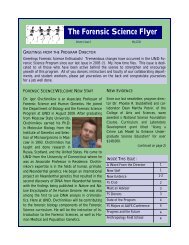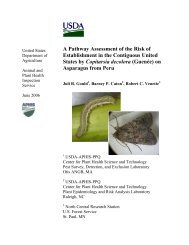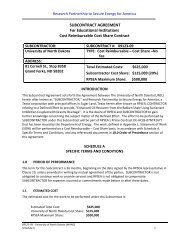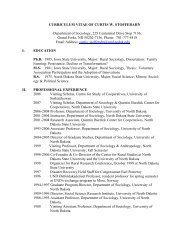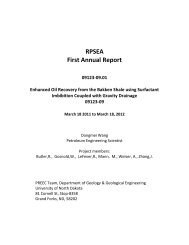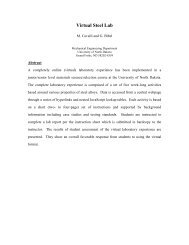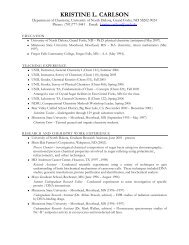Dirigent proteins in conifer defense: gene discovery, phylogeny, and ...
Dirigent proteins in conifer defense: gene discovery, phylogeny, and ...
Dirigent proteins in conifer defense: gene discovery, phylogeny, and ...
You also want an ePaper? Increase the reach of your titles
YUMPU automatically turns print PDFs into web optimized ePapers that Google loves.
25<br />
PCR system (Strata<strong>gene</strong>, La Jolla, USA) us<strong>in</strong>g<br />
SYBR green QRT-PCR reagents (Strata<strong>gene</strong>)<br />
accord<strong>in</strong>g to the manufacturer’s <strong>in</strong>structions. Reaction<br />
mixtures conta<strong>in</strong>ed 0.5 ll of cDNA as template,<br />
0.5 pmol of each primer <strong>and</strong> 12.5 ll of SYBR<br />
green reagent <strong>in</strong> a f<strong>in</strong>al volume of 25 ll. A master<br />
mix of cDNA <strong>and</strong> 2 SYBR green reagent was used<br />
to ensure that each reaction conta<strong>in</strong>ed an equal<br />
amount of cDNA. Gene-specific primers for each<br />
DIR were designed with<strong>in</strong> the 3‘UTR sequence<br />
(Supplemental Table VI). Primer specificity (s<strong>in</strong>gle<br />
product of expected length) was confirmed by<br />
analysis on a 2% agarose gel <strong>and</strong> by melt<strong>in</strong>g curve<br />
analysis (data not shown). Primers for spruce<br />
b-act<strong>in</strong> were designed (GenBank accession number<br />
CO232865) <strong>and</strong> served as a quantification control.<br />
The program for all PCR reactions was: 95 °C for<br />
10 m<strong>in</strong>; 40 cycles of 15 s at 95 °C, 1 m<strong>in</strong> at 55 °C,<br />
<strong>and</strong> 30 s at 72 °C. Data were analyzed us<strong>in</strong>g<br />
MX3000Pä Real-Time PCR system software<br />
(Strata<strong>gene</strong>). All PCR reactions consisted of at<br />
least two technical replicates. Transcript abundance<br />
of each DIR <strong>gene</strong> was normalized to b-act<strong>in</strong> by<br />
subtract<strong>in</strong>g the Ct value of b-act<strong>in</strong> from the Ct<br />
value of each DIR <strong>gene</strong>, where DCt = DCt DIR_isoform<br />
) DCtb)act<strong>in</strong>. Transcript abundance of the DIR<br />
<strong>gene</strong>s <strong>in</strong> control <strong>and</strong> treated samples were obta<strong>in</strong>ed<br />
from the equation (1 + E) )DCt , where E is the PCR<br />
efficiency, as described by Ramakers et al. (2003),<br />
which is derived from the log slope of the fluorescence<br />
versus cycle number <strong>in</strong> the exponential phase<br />
of each <strong>in</strong>dividual amplification plot, us<strong>in</strong>g the<br />
equation (1 + E) =10 slope .<br />
Results<br />
Discovery of wound- <strong>and</strong> <strong>in</strong>sect-<strong>in</strong>duced DIR<br />
<strong>gene</strong>s by microarray analysis<br />
We <strong>in</strong>itially <strong>in</strong>vestigated a possible role for DIR<br />
<strong>prote<strong>in</strong>s</strong> <strong>in</strong> the wound- <strong>and</strong> <strong>in</strong>sect-<strong>in</strong>duced <strong>defense</strong><br />
response of Sitka spruce as part of a larger<br />
microarray study of transcriptional changes <strong>in</strong><br />
spruce <strong>defense</strong> aga<strong>in</strong>st the white p<strong>in</strong>e weevil (the<br />
complete microarray analysis will be published<br />
elsewhere; S. Ralph <strong>and</strong> J. Bohlmann unpublished<br />
results). In brief, 2-year-old Sitka spruce sapl<strong>in</strong>gs<br />
were subjected to either feed<strong>in</strong>g by adult white p<strong>in</strong>e<br />
weevils or mechanical wound<strong>in</strong>g. Transcript profiles<br />
were monitored 2, 6 <strong>and</strong> 48 h after the onset of<br />
treatment, <strong>and</strong> compared to untreated control<br />
trees us<strong>in</strong>g a cDNA microarray pr<strong>in</strong>ted with<br />
16 756 unique elements derived from 11 spruce<br />
cDNA libraries. At the peak response (48 h) to<br />
weevil herbivory, 2393 or 14.2% of array elements<br />
were differentially expressed (fold change > 1.5,<br />
P < 0.05 relative to untreated control trees), compared<br />
to only 582 or 3.4% differentially expressed<br />
after 2 h of <strong>in</strong>sect feed<strong>in</strong>g. The response to<br />
mechanical wound<strong>in</strong>g was considerably more<br />
rapid, peak<strong>in</strong>g at 2 h with 2348 or 14.0% of<br />
array elements differentially expressed, <strong>and</strong> this<br />
dim<strong>in</strong>ished to 1203 or 7.1% by 48 h. Six<br />
array elements (IS0011_E22, IS0013_K10,<br />
IS0013_G20, WS00913_G16, WS00914_H24 <strong>and</strong><br />
WS01011_J07) with high similarity to plant DIR<br />
<strong>gene</strong>s demonstrated substantially <strong>in</strong>creased hybridization<br />
signals with RNA from spruce bark <strong>in</strong><br />
response to both the mechanical wound<strong>in</strong>g <strong>and</strong><br />
<strong>in</strong>sect feed<strong>in</strong>g treatments (Table 1). Up-regulation<br />
of transcripts hybridiz<strong>in</strong>g with several of the DIR<br />
elements on the microarray was evident after as<br />
little as 2 h of <strong>in</strong>sect feed<strong>in</strong>g, at which po<strong>in</strong>t feed<strong>in</strong>g<br />
damage on sapl<strong>in</strong>g stems was limited to fewer than<br />
5 feed<strong>in</strong>g holes per tree. The magnitude of <strong>in</strong>duction<br />
cont<strong>in</strong>ued to <strong>in</strong>crease up to 48 h, by which<br />
time the number of feed<strong>in</strong>g holes had <strong>in</strong>creased to<br />
>20 per tree. In contrast, the response to mechanical<br />
wound<strong>in</strong>g was more pronounced <strong>and</strong> rapid,<br />
with peak <strong>in</strong>duction of transcripts hybridiz<strong>in</strong>g to<br />
DIR elements at 6 h post-treatment, <strong>and</strong> a dim<strong>in</strong>ish<strong>in</strong>g<br />
response to 48 h. The differ<strong>in</strong>g temporal<br />
response to <strong>in</strong>sect herbivory <strong>and</strong> mechanical<br />
wound<strong>in</strong>g treatments likely reflects the slow, but<br />
cont<strong>in</strong>uous feed<strong>in</strong>g by weevils compared with a<br />
one time wound<strong>in</strong>g event by needle at <strong>in</strong>ception. It<br />
is noteworthy that at least one DIR element (i.e.<br />
WS0083_C01) on the microarray showed significantly<br />
down-regulated transcript levels <strong>in</strong> response<br />
to weevil feed<strong>in</strong>g <strong>and</strong> mechanical damage, while<br />
the rema<strong>in</strong><strong>in</strong>g 10 DIR elements were mostly<br />
unresponsive to these treatments.<br />
cDNA clon<strong>in</strong>g of a family of 19 DIR<br />
<strong>and</strong> DIR-like <strong>gene</strong>s from spruce<br />
A TBLASTN search of the Treenomix spruce EST<br />
database (www.treenomix.com) conta<strong>in</strong><strong>in</strong>g 77 160<br />
3¢-end sequences was performed with publicly<br />
available plant DIR sequences (Kim et al., 2002)<br />
<strong>and</strong> led to the identification of 96 putative spruce






